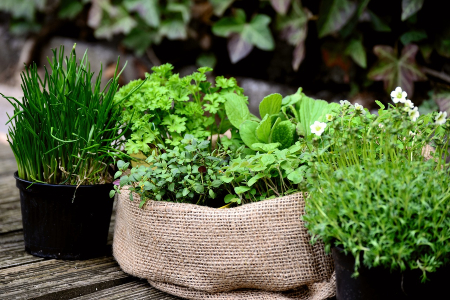We ask you, urgently: don't scroll past this
Dear readers, Catholic Online was de-platformed by Shopify for our pro-life beliefs. They shut down our Catholic Online, Catholic Online School, Prayer Candles, and Catholic Online Learning Resources essential faith tools serving over 1.4 million students and millions of families worldwide. Our founders, now in their 70's, just gave their entire life savings to protect this mission. But fewer than 2% of readers donate. If everyone gave just $5, the cost of a coffee, we could rebuild stronger and keep Catholic education free for all. Stand with us in faith. Thank you.Help Now >
God's Pharmacy - The Use of Herbs in Catholic Medicine Through the Ages
FREE Catholic Classes
Since the dawn of humanity, herbs have been revered for their healing properties. Within the Catholic tradition, these gifts from God have played a pivotal role in medicine, reflecting the belief that God's creation provides remedies for human ailments. This article explores the rich history of herbal medicine in the Catholic Church, demonstrating the efficacy of these natural treatments and their divine origin.

Photo credit: congerdesign
Highlights
6/12/2024 (10 months ago)
Published in Health
Keywords: Catholic medicine, herbal remedies, Biblical healing, monastic infirmaries, Saint Hildegard of Bingen, divine providence, natural health
The Bible provides numerous references to the use of plants and herbs for healing. In Genesis 1:29, God declares, "I give you every seed-bearing plant on the face of the whole earth and every tree that has fruit with seed in it. They will be yours for food." This passage underscores the belief that God endowed the Earth with plants for sustenance and healing. Additionally, in Ezekiel 47:12, it is written, "Their fruit will serve for food and their leaves for healing," directly linking the use of plants to medicinal purposes.
Buy your herbs from a Catholic source: freshharvestmarket.com
Throughout history, the Catholic Church has been a steward of herbal medicine. Monastic communities, particularly during the medieval period, became centers of medical knowledge and herbal remedies. Monks meticulously cultivated herb gardens, which included plants such as lavender, mint, and rosemary, known for their healing properties. These gardens were not just for culinary purposes but were integral to the monastic infirmaries where monks treated the sick.
Monastic gardens were essential to medieval medicine. Commonly used herbs included lavender, used for its calming effects and antiseptic properties; mint, employed for digestive issues and as a general tonic; and rosemary, valued for its ability to improve memory and circulation. These herbs were crucial in the daily operations of monastic infirmaries, where monks provided care to the sick and injured.
One notable figure in the history of Catholic herbal medicine is Saint Hildegard of Bingen (1098-1179). A Benedictine abbess, Hildegard wrote extensively on the medicinal use of plants in her works "Physica" and "Causae et Curae." She believed that health was a balance of bodily humors and that herbs could restore this balance. Hildegard's holistic approach to medicine emphasized the interconnectedness of body, mind, and spirit, a philosophy that resonates with modern integrative medicine.
The efficacy of herbal medicine in monastic infirmaries is well-documented. Monks recorded numerous successful treatments using herbal remedies. These records provide valuable insights into the practical applications of herbs in medieval medicine. For instance, monks used willow bark for pain relief, a precursor to modern aspirin; echinacea to treat infections, known for its immune-boosting properties; and St. John's Wort for depression, a practice still recognized today.
The transition of herbal knowledge from the Renaissance to modern times saw the integration of herbal practices into mainstream medicine. This period witnessed a growing appreciation for the medicinal properties of plants and their applications in treating various ailments.
The efficacy of herbal medicine is well-documented, both historically and in contemporary research. For instance, the use of willow bark for pain relief dates back to ancient times and is the precursor to modern aspirin. The Church's endorsement of such remedies is seen in the numerous records of successful treatments in monastic infirmaries.
The use of willow bark for pain relief is a classic example of the transition from traditional herbal remedies to modern pharmaceuticals. Willow bark contains salicin, which is chemically similar to aspirin. This historical use has paved the way for modern pain relief methods.
Echinacea has been used historically to treat infections. Modern research validates its immune-boosting properties, demonstrating the enduring relevance of traditional herbal remedies.
The use of St. John's Wort for depression dates back to medieval herbalism. Today, it is recognized for its efficacy in treating mild to moderate depression, bridging the gap between historical practice and modern acceptance.
The use of herbs in Catholic medicine is not merely a pragmatic choice but is deeply rooted in theological reflection. It reflects the belief in divine providence and the goodness of God's creation. The Catechism of the Catholic Church teaches that "God wills the interdependence of creatures" (CCC 340), which includes the interdependence between humans and the plant kingdom for health and healing.
Buy your herbs from a Catholic source: freshharvestmarket.com
The Church's sacramental worldview sees the material world as a conduit of God's grace. Herbs, as part of this creation, are seen as instruments through which God's healing power is manifested. This perspective invites a profound appreciation of the natural world and a responsibility to steward it wisely.
Today, the integration of herbal remedies continues in various Catholic health practices. Herbs are used in conjunction with modern medicine to provide holistic care, reflecting the Church's enduring commitment to the healing power of God's creation.
The use of herbs in Catholic medicine is a testament to the enduring belief in the healing power of God's creation. From Biblical times to the present, these natural remedies have been valued for their efficacy and their divine origin. As modern medicine continues to uncover the benefits of herbal treatments, the wisdom of the Church's tradition in using these gifts from God becomes ever more apparent.
Buy your herbs from a Catholic source: freshharvestmarket.com
Join the Movement
When you sign up below, you don't just join an email list - you're joining an entire movement for Free world class Catholic education.

-

- Stations of the Cross
- Easter / Lent
- 5 Lenten Prayers
- Ash Wednesday
- Living Lent
- 7 Morning Prayers
- Mysteries of the Rosary
- Litany of the Bl. Virgin Mary
- Popular Saints
- Popular Prayers
- Female Saints
- Saint Feast Days by Month
- Pray the Rosary
The Way of the Cross: A Good Friday Reflection on Christ’s Final Journey
The Many Reasons Why We Call it Good Friday
“It Is Finished”: The Silence of Good Friday and the Triumph of the Cross
Daily Catholic
 Daily Readings for Saturday, April 19, 2025
Daily Readings for Saturday, April 19, 2025 St. Alphege: Saint of the Day for Saturday, April 19, 2025
St. Alphege: Saint of the Day for Saturday, April 19, 2025 Stewardship Prayer: Prayer of the Day for Saturday, April 19, 2025
Stewardship Prayer: Prayer of the Day for Saturday, April 19, 2025 Daily Readings for Friday, April 18, 2025
Daily Readings for Friday, April 18, 2025 St. Apollonius the Apologist: Saint of the Day for Friday, April 18, 2025
St. Apollonius the Apologist: Saint of the Day for Friday, April 18, 2025- Aspiration: Prayer of the Day for Friday, April 18, 2025
![]()
Copyright 2025 Catholic Online. All materials contained on this site, whether written, audible or visual are the exclusive property of Catholic Online and are protected under U.S. and International copyright laws, © Copyright 2025 Catholic Online. Any unauthorized use, without prior written consent of Catholic Online is strictly forbidden and prohibited.
Catholic Online is a Project of Your Catholic Voice Foundation, a Not-for-Profit Corporation. Your Catholic Voice Foundation has been granted a recognition of tax exemption under Section 501(c)(3) of the Internal Revenue Code. Federal Tax Identification Number: 81-0596847. Your gift is tax-deductible as allowed by law.


 Daily Readings for Saturday, April 19, 2025
Daily Readings for Saturday, April 19, 2025 St. Alphege: Saint of the Day for Saturday, April 19, 2025
St. Alphege: Saint of the Day for Saturday, April 19, 2025 Stewardship Prayer: Prayer of the Day for Saturday, April 19, 2025
Stewardship Prayer: Prayer of the Day for Saturday, April 19, 2025 St. Apollonius the Apologist: Saint of the Day for Friday, April 18, 2025
St. Apollonius the Apologist: Saint of the Day for Friday, April 18, 2025

